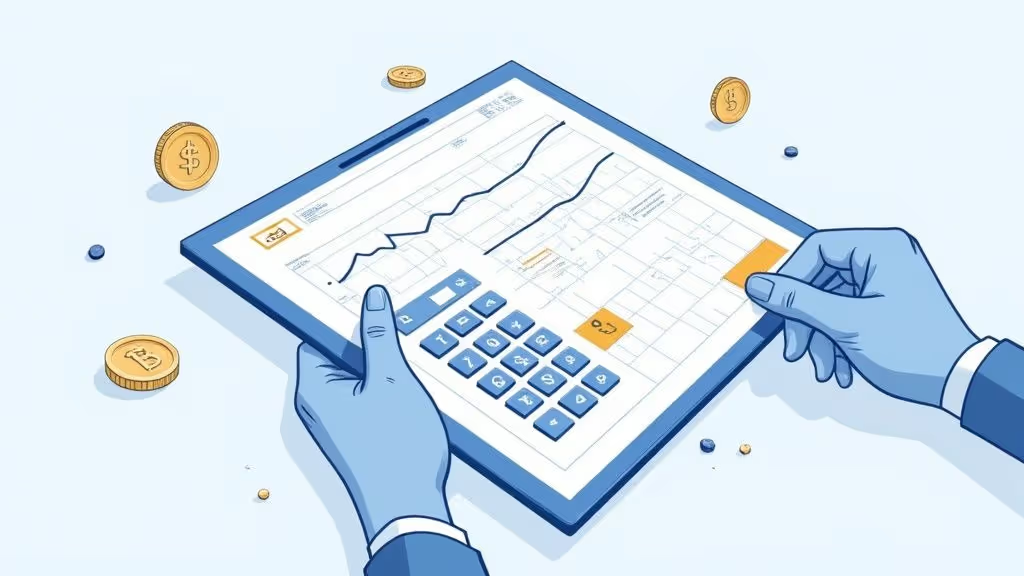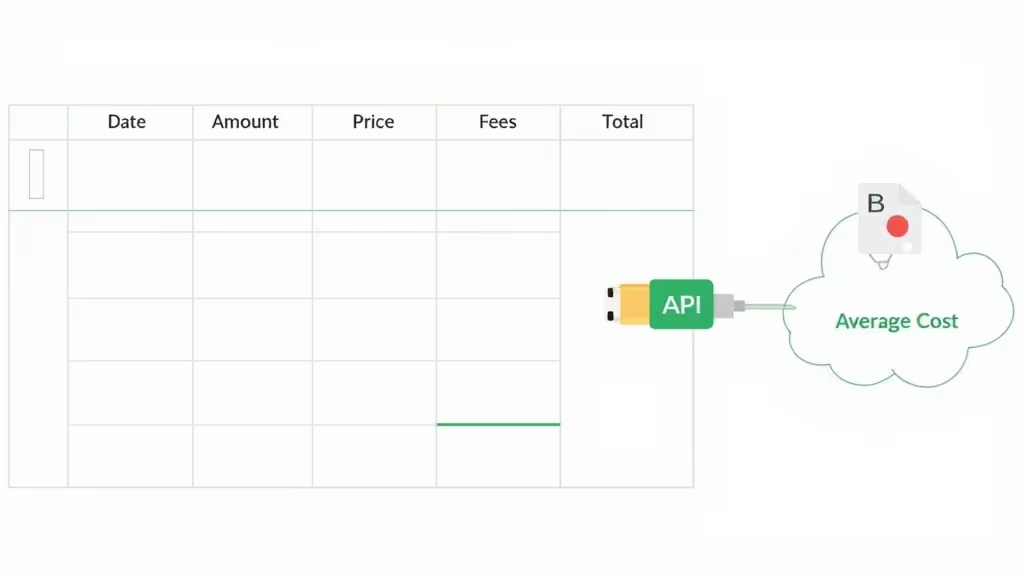Your Guide to a Whale Tracker App
Discover how a whale tracker app can give you a market edge. Learn to track smart money, analyze on-chain signals, and make smarter crypto trading decisions.

December 20, 2025
Wallet Finder

November 7, 2025

A crypto average calculator is a tool that tells you the true average price you paid for a cryptocurrency after buying it multiple times. This number, known as your cost basis, is essential for tracking profits, making smarter trades, and dealing with taxes without having to guess.

Let's be honest—keeping track of your crypto portfolio gets messy, and it gets messy fast. You buy some Bitcoin today, snag a bit more next week during a dip, and suddenly you have no real clue what your actual entry price is. Trusting your memory or a rough estimate is a common trap, and in a market this volatile, it's an expensive one.
This is exactly where a crypto average calculator becomes one of your most valuable tools. It slices through the confusion and gives you a single, powerful number: your cost basis. This figure represents the true weighted average price you've paid for a coin, factoring in all your different purchases and even those pesky fees.
To really get a handle on this, it helps to know the lingo. These are the core components you'll be working with every time you calculate your average cost.
TermWhat It Means for YouSimple ExampleCost BasisThe total amount you've spent to acquire a crypto asset, including all fees. It's your financial starting line.You bought 1 ETH for $3,000 and paid a $20 fee. Your cost basis is $3,020.Average PriceThe per-unit cost of your holdings. It's your total cost basis divided by the total number of coins you own.If you have 2 ETH with a total cost basis of $6,000, your average price is $3,000 per ETH.Weighted AverageA calculation that considers both the price and the quantity of each purchase to find a true average.Buying 1 ETH at $3,000 and 0.5 ETH at $2,800 gives you a weighted average price, not a simple average of the two prices.Profit/Loss (P/L)The difference between the current market value of your holdings and your total cost basis.If your ETH is now worth $7,000 and your cost basis was $6,000, you have a $1,000 unrealized profit.
Getting these terms down makes every other step feel much more intuitive. You're no longer just looking at numbers; you're understanding the story they tell about your investment.
Without an accurate cost basis, you're flying blind. You might feel like you're in profit when you’re actually at a loss, or the other way around. This lack of clarity leads directly to bad decisions, like selling way too early or holding on too long because your assumptions are flawed.
A precise cost basis is the foundation of effective portfolio management. It transforms ambiguous feelings about your investments into concrete data, allowing you to strategize with confidence rather than emotion.
Knowing this one number brings immediate clarity to your entire strategy:
The crypto market's explosive growth makes precise tracking more critical than ever. The global cryptocurrency market was valued at USD 5,702.5 million in 2024 and is projected to hit USD 11,713.1 million by 2030. You can dig into more market growth insights from Grand View Research. As more investors pile in, the need for reliable tools to manage portfolios effectively becomes undeniable.
Simply guessing your numbers isn't a sustainable strategy. By taking the time to calculate your average cost, you shift from being a speculative participant to a strategic investor who understands their financial position with absolute certainty.
Ready to ditch the guesswork and find your true cost basis? The good news is the actual math is way simpler than it sounds. It’s all about finding the weighted average, which just means that your larger buys have a bigger impact on the final average price. This gives you a much more realistic picture of your investment.
At its core, the process is just three simple actions: pulling together your transaction data, adding up your costs and coins, and then doing one quick division.
Let's walk through it with a real-world example.
First thing's first: you need to round up all your purchase records for a specific crypto, like Bitcoin. You can usually download this history as a CSV file straight from the exchange you used.
Let's imagine you've been dollar-cost averaging into Bitcoin for a few months. Your purchase history might look something like this:
Transaction DateAmount Spent (USD)BTC ReceivedPrice per BTCJanuary 15$5000.0125 BTC$40,000February 5$3000.0070 BTC$42,857March 20$7000.0150 BTC$46,667
Heads up: Make absolutely sure your "Amount Spent" column includes any transaction or trading fees. These are a part of your acquisition cost, and skipping them—even the small ones—will mess up your numbers by understating your cost basis and overstating your potential profits.
Once you have your data lined up, it's just basic arithmetic. You need to find two key totals from your transaction history:
Using our Bitcoin example from above:
And that's it. You have everything you need for the final calculation. The formula for your weighted average cost is incredibly simple but powerful.
The Average Cost Formula
(Total Amount Spent) / (Total Crypto Received) = Your Average Cost Per Coin
Plugging our numbers into the formula:
$1,500 / 0.0345 BTC = $43,478.26 per BTC
That number, $43,478.26, is your true cost basis per Bitcoin. It’s your breakeven price. If the market is trading above this, you're in profit. If it's below, you're sitting on an unrealized loss.
Nailing this down is the first real step to mastering your portfolio. It's also the exact number you'll need when it's time to calculate your crypto profit down the line.
Getting comfortable with this manual calculation is a fantastic way to understand the mechanics behind your investments. And as crypto becomes more mainstream, these skills are only getting more important. According to the 2025 Global State of Crypto Report by Gemini, nearly one in four (24%) people surveyed across several major countries now own crypto.
The simple weighted average formula is a great starting point, but the crypto market rarely keeps things that simple. In the real world, you'll constantly run into two things that can mess up your calculations: transaction fees and partial sales.
Ignoring these is a surefire way to get an inaccurate cost basis, which completely defeats the purpose of tracking your portfolio. Let's walk through exactly how to handle both so your numbers stay razor-sharp. If you want to see how top traders interpret market trends and make smarter moves, A Trader's Guide to the Smart Money Index provides a clear roadmap.
This flow chart gives a great visual of how individual buys, with all their details, roll up into a single, accurate average price.

As you can see, every little cost and quantity matters. The average price is the final output, so getting the inputs right is everything.
Every time you buy, sell, or swap crypto, you're almost guaranteed to pay a fee. It could be an exchange fee, a network gas fee, or a withdrawal fee. They might seem small, but these costs are a critical part of your acquisition cost and they absolutely add up.
You have to think of fees as part of the total price tag. If you buy 1 ETH for $3,000 but pay a $25 network fee, your actual cost for that trade wasn't $3,000—it was $3,025.
The only correct way to handle fees is to add them directly to the cost of each purchase. If you don't, you're understating your cost basis. That makes your profits look bigger than they really are and could lead you to overpay on taxes.
This is especially true if you’re trading often. For anyone deep in the DeFi space, our guide on how to track gas fees for high-frequency DeFi trades is a must-read to see just how quickly these costs can stack up.
Selling a portion of your holdings is probably the number one thing that trips people up when using a crypto average calculator. It feels complicated, but the logic is simple. When you sell some of your crypto, your total holding goes down, but your average cost for the coins you still hold doesn't change.
Let’s make this crystal clear with an example.
Imagine you own 2 ETH, and your total cost basis is $6,000. That gives you an average price of $3,000 per ETH.
Now, you decide to sell 0.5 ETH. To update your records properly, you need to subtract the cost basis of the portion you just sold.
With that number, you can update your portfolio totals:
So, what's the average cost for the ETH you have left? You guessed it—it's still the same.
$4,500 / 1.5 ETH = $3,000 per ETH
Your average price per coin only changes when you buy more at a different price. When you sell, you're just cashing out a piece of your investment at its existing average cost. Understanding this difference is absolutely crucial for accurate profit and loss tracking.
Doing the math by hand is a great way to really get the mechanics of your portfolio's cost basis. But let's be honest—it's tedious, time-consuming, and an open invitation for human error, especially once your transaction list starts to grow.
The good news is you don't have to live in spreadsheet hell forever. There are some fantastic tools out there that can simplify things or even put the entire process on autopilot. This is where a good template or a dedicated portfolio tracker becomes a total game-changer, handling all the complex stuff we've talked about so you know your numbers are always spot-on.
To help you get started on the right foot, we put together a free, no-fuss Google Sheets template. Think of it as the perfect middle ground between scribbling on a notepad and plugging into a fully automated system. It gives you all the structure and pre-built formulas to do the heavy lifting for you.
Our template is set up to track every piece of data you need for an accurate average cost calculation:
From there, the built-in formulas take over. They'll automatically calculate your running total cost, your total holdings, and—the main event—your continuously updated weighted average price. It’s a dead-simple way to use a crypto average calculator without getting tangled up in the formulas yourself.
A spreadsheet is a huge step up from manual math, but the ultimate solution for truly effortless tracking is a dedicated portfolio tracker. These platforms are designed to connect directly to your various exchange accounts and wallet addresses using secure APIs, creating a completely seamless, hands-off system.
This approach means you can finally say goodbye to manual data entry for good.
Once you're connected, an automated tracker pulls your entire transaction history—buys, sells, swaps, even staking rewards. It crunches all the numbers in real-time, giving you a live, accurate view of your cost basis and P&L across your whole portfolio.
Platforms like Wallet Finder.ai are built to transform this raw, messy on-chain data into clear, actionable insights. Just take a look at how a platform like this can present your portfolio data.

This kind of dashboard view consolidates all your holdings, showing your net worth, profit and loss, and how each individual asset is performing at a glance. It’s a level of clarity that you just can't get when you're tracking things manually.
Here's a comparison of manual vs. automated tracking:
FeatureManual Tracking (Spreadsheet)Automated TrackerSetup TimeQuick to start, but requires manual formula setup.Initial setup to connect accounts, then runs automatically.Data Entry100% manual. Every transaction must be entered.Automatic sync via API or wallet address. Zero manual entry.AccuracyProne to human error (typos, forgotten fees).Highly accurate, as data is pulled directly from the source.Real-Time ViewOnly as up-to-date as your last manual entry.Live, real-time updates on P&L and cost basis.Tax ReportingRequires manual calculations and report creation.Often includes automated tax report generation.Best ForBeginners with few transactions or those wanting to learn.Active traders or investors with multiple wallets/exchanges.
Making that jump to automation pays off in a few key ways:
Picking the right tool is a critical part of managing your investments well. To help you sort through the options, we put together a detailed guide on the best crypto portfolio tracker platforms out there today. Whether you stick with a template or go for full automation, the right tool ensures your financial decisions are built on solid data, not guesswork.
Figuring out your cost basis seems straightforward on the surface, but a few common slip-ups can throw your numbers off completely. Avoiding these mistakes is just as crucial as learning the formula itself if you want your financial decisions to be based on solid data.
Here's a quick checklist of pitfalls to watch out for:
Pro Tip: Think of fees as part of the purchase price. If you buy 1 ETH for $3,000 and pay a $20 gas fee, your real cost for that transaction is $3,020. Getting into the habit of adding these small amounts keeps your cost basis precise.
It’s surprisingly easy to mix up accounting methods without even realizing it. While the weighted average cost method is popular and simple, tax authorities in different regions might actually require something else.
MethodHow It WorksCommon Use CaseAverage CostPools all assets to create one average entry price.Great for personal P&L tracking; accepted in some regions for taxes.First-In, First-Out (FIFO)Assumes the first coins you bought are the first ones you sell.Required or default method for tax purposes in many countries (e.g., USA).Last-In, First-Out (LIFO)Assumes the last coins you bought are the first ones you sell.Less common for crypto taxes, but used in traditional accounting.
Confusing these can cause massive headaches and lead to major discrepancies in your capital gains calculations. For instance, tax rules in the UK use a specific variation of pooling and FIFO, which can result in a totally different taxable gain than a simple weighted average calculation would show.
This is where a good crypto average calculator or a dedicated portfolio tracker can save the day. They automate the correct application of these rules, preventing costly mistakes when tax season rolls around. By staying aware of these common pitfalls, you can keep your records straight and manage your crypto portfolio with much more confidence.
Even with the best tools, crunching the numbers on your crypto cost basis can leave you with a few lingering questions. Let's tackle some of the most common ones I hear from investors so you can manage your portfolio with confidence.
No, you don’t pay taxes on unrealized gains. Think of these as "paper profits"—the potential gains on assets you're still holding.
A taxable event only gets triggered when you realize that gain. This happens when you dispose of the asset, which in the crypto world means selling it for cash, trading it for another crypto, or even spending it on goods and services. You might be sitting on a massive unrealized profit, but you don't owe a dime on it until you actually make a move.
This is a great question and a point of confusion for many. When you earn rewards from staking or yield farming, those rewards are usually treated as income, valued at their fair market price on the day you received them.
So, how does that play into your cost basis? It's a two-step process:
Let's say you earn 0.1 ETH from staking when ETH is trading at $3,000. You've just generated $300 of taxable income. At the same time, the cost basis for that specific 0.1 ETH is now set at $300. You'd then add these new coins to your total holdings, which will slightly adjust your overall weighted average price.
This is where a lot of people get tripped up. The P&L your portfolio tracker shows is your net profit, but your taxable gain is a specific calculation based on the rules set by tax authorities like the IRS or HMRC. The two are rarely the same.
Here’s a classic scenario: you have an overall net loss for the year but still owe a surprising amount in taxes. How? You might have realized some big gains early in the year before a market crash. Those sales are locked-in taxable events, no matter what happened to your portfolio's value afterward.
That’s exactly why just glancing at your portfolio's current balance isn't enough for proper tax planning. A good crypto average calculator tracks each sale or trade as a distinct realized event, giving you a true picture of your tax liability and helping you avoid any nasty surprises.
Ready to stop guessing and start making data-driven trades? Wallet Finder.ai gives you the tools to analyze on-chain data, track profitable wallets, and discover opportunities before the market moves. Find your edge and mirror the strategies of top traders in real time. Start your 7-day trial of Wallet Finder.ai today.
"I've tried the beta version of Walletfinder.ai extensively and I was blown away by how you can filter through the data, and the massive profitable wallets available in the filter presets, unbelievably valuable for any trader or copy trader. This is unfair advantage."
.avif)
Pablo Massa
Experienced DeFi Trader